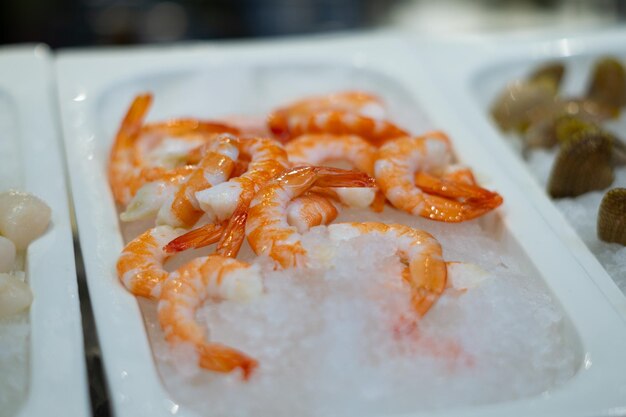How Long Does Fresh Shrimp Last in the Refrigerator? Your Guide to Safe Shrimp Storage
Imagine preparing a delicious meal featuring fresh shrimp and realizing you might not know how long it can stay safe in the refrigerator. This common situation is something many seafood enthusiasts face. Understanding how to store shrimp correctly can help you enjoy its rich flavors while avoiding foodborne illness. In this comprehensive guide, you'll discover how long fresh shrimp remains good in the refrigerator, along with tips for maximizing its shelf life.
🦐 Understanding Fresh Shrimp Shelf Life
When it comes to shrimp, freshness is key to both flavor and safety. Refrigeration slows bacterial growth, but doesn't entirely stop it, which is why knowing how long shrimp can safely reside in your fridge is important.
Average Shelf Life: Generally, fresh shrimp can be safely stored in the refrigerator for 1 to 2 days. This short time frame is due to the shrimp's moist, delicate nature, which is prone to rapid spoilage.
Factors Affecting Shrimp Freshness
Several factors influence how long shrimp stays fresh:
- Temperature: Ideally, shrimp should be stored at or below 40°F (4°C).
- Packaging: Airtight containers or vacuum-sealed bags are optimal for minimizing exposure to air and bacteria.
- Freshness at Purchase: The closer the shrimp is to its catch date, the longer it will last at home.
- Type of Shrimp: Peeled and deveined shrimp may have a slightly different shelf life compared to shell-on varieties due to differences in processing.
🧊 Tips for Extending Shrimp Shelf Life
Proper storage techniques can significantly extend the freshness of your shrimp. Here are some practical tips:
Immediate Refrigeration
Upon returning home with your shrimp, store it immediately in the coldest part of your refrigerator to maintain its quality and safety.
Use a Cold Pack
Placing shrimp on a cold pack or chilling tray within the fridge can marginally extend its lifespan by keeping it at an optimal temperature.
Airtight Storage
Seal your shrimp tightly in an airtight container or a vacuum-sealed bag. This technique minimizes contact with air, which can accelerate spoilage.
Minimal Handling
Reduce the amount of handling to avoid transferring bacteria from hands or surfaces onto the shrimp.
🐟 Identifying Spoiled Shrimp
Knowing when shrimp has gone bad is crucial for avoiding unpleasant and unsafe meals. Here are some common signs of spoilage:
- Unpleasant Odor: Fresh shrimp typically has a mild, ocean-like smell. An ammonia or sour scent indicates spoilage.
- Discoloration: Fresh shrimp should appear translucent and slightly gray. Black spots or a yellowish tint are warning signs.
- Texture: If the shrimp feels slimy or mushy, it’s best to err on the side of caution and discard it.
🌡️ Freezing as an Alternative
Freezing shrimp can significantly extend its shelf life while maintaining quality.
How to Properly Freeze Shrimp
- Cleaning: Rinse the shrimp under cold water and pat dry.
- Packaging: Use freezer-safe bags or containers, and remove as much air as possible.
- Labeling: Date the packaging, so you know how long it’s been stored.
- Quick Freeze: Place the shrimp in the coldest part of your freezer, ensuring they lay flat for quicker freezing.
Thawing Frozen Shrimp
When it's time to use the shrimp, plan how to thaw it correctly to maintain quality:
- Refrigeration Thawing: The safest method is to transfer frozen shrimp from the freezer to the fridge and allow it to thaw slowly.
- Cold Water Thawing: Submerge sealed shrimp in cold water for a quicker option, changing the water every 30 minutes.
📋 Quick Reference Summary
Here's a handy reference to keep your shrimp at its best:
Refrigerator Lifespan: 1-2 days at ≤40°F (4°C)
Key Storage Tips:
- Use airtight containers 🥡
- Refrigerate immediately ❄️
- Handle minimally 👐
Spoilage Indicators:
- Off smells 👃
- Unnatural colors 🎨
- Slimy texture 🤢
Freezing Tips:
- Pack tightly and label 📆
- Choose proper thawing methods 🌬️
Avoiding Spoilage:
- Cook or freeze shrimp within 1-2 days of purchasing
💡 Beyond Shrimp: Food Safety and Storage Tips
While shrimp is a delicacy worth protecting, these tips can apply to other perishable foods in your kitchen:
Inventory Rotation
Use the FIFO method (First In, First Out) to keep track of freshness. Always place newer items behind or beneath older ones to consume them first.
Temperature Control
Invest in a fridge thermometer to ensure that your refrigerator accurately maintains a safe temperature (at or below 40°F).
Regular Cleaning
Frequently clean your refrigerator to prevent contamination and eliminate old, expired items.
🍽️ Conclusion: Making the Most of Your Seafood
Understanding how long fresh shrimp is good in the refrigerator allows for better meal planning, less food waste, and safe consumption. Remember, the best way to ensure freshness is to purchase high-quality shrimp and to store it correctly immediately after buying. Whether preparing a simple shrimp cocktail or an elaborate dish, you'll enjoy your seafood at its peak flavor and safety by following these guidelines.
